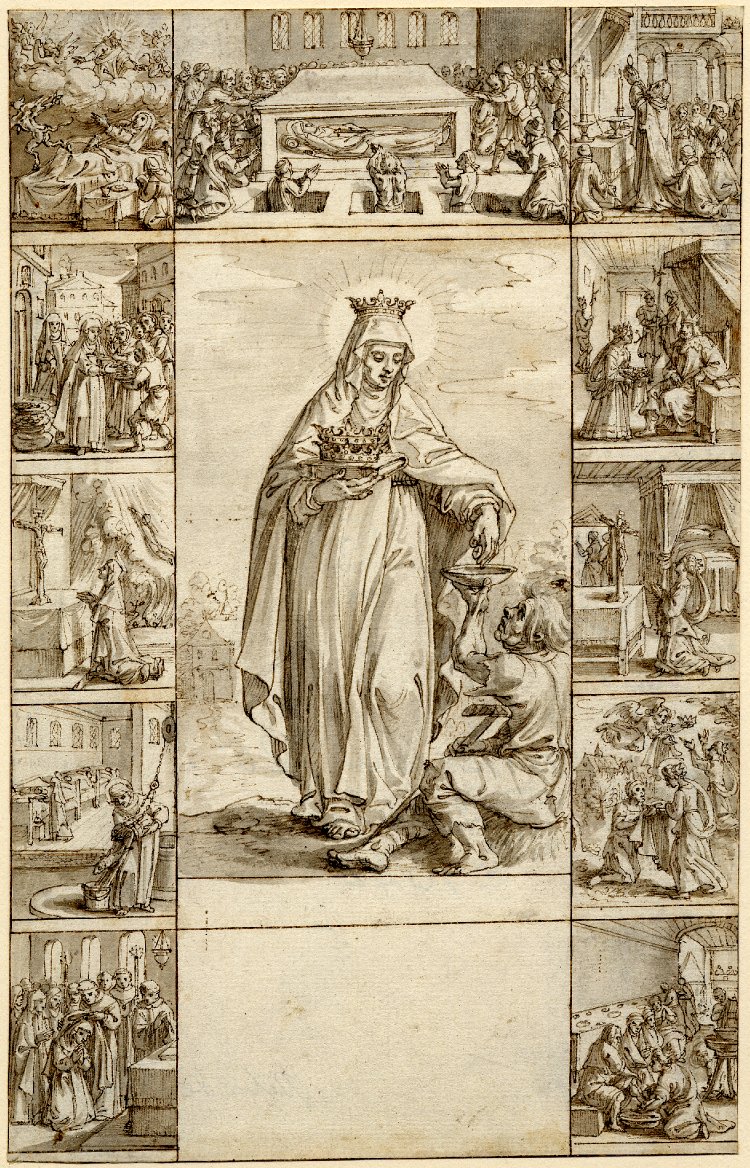PIETER DE JODE I (Antwerp 1573 – 1634 Antwerp)
Pieter de Jode (Antwerp 1573 – 1634 Antwerp)
Four Scenes from the Life of a Monastic Saint
Each pen and brown ink, brown wash, brown ink framing lines, 49 x 39 mm (1.9 x 1.5 inch)
Provenance
~ Anthony Freire Marreco (1915–2006)
~ De Gimbe collection, Brussels
***
Pieter de Jode was born as the son of Gerard de Jode (c.1517–1591) of Nijmegen, who had settled in Antwerp as printmaker and publisher by 1547.1 According to Carel van Mander’s Schilder-boeck of 1604 Pieter was taught by Hendrick Goltzius, presumably in the late 1580s or early 1590s. Around 1595 De Jode travelled to Siena, Venice, Rome and Paris. He became a member of the Antwerp guild of St Luke in 1600 as ‘plaatsnijder’ (engraver), and married Suzanna Verhulst in 1602, the sister-in-law of Jan Brueghel the Elder and niece of Pieter Coecke van Aelst.
De Jode is mostly known as an engraver and publisher. During his Italian sojourn he engraved models by Francesco Vanni, Titian and Jacopo Bassano. Upon his return to Antwerp he worked for the publisher Christoffel Plantijn, engraving after designs by Sebastiaen Vrancx, Otto van Veen, Rubens and Van Dyck. He also made prints after drawings by Adriaen van de Venne for Jacob Cats’s Houwelick of 1625. De Jode must also have drawn many designs himself, which were engraved either by himself or by other printmakers.2 Many engravings however did not credit the name of the designing draftsman, and De Jode’s activity in this field is likely to be much larger than currently known.3
It is possible these four scenes were cut from a larger sheet, where they may have formed a border – an intact sheet with eleven scenes from the life of St Elizabeth of Hungary is preserved in the British Museum, London (fig.).4 In the London sheet the small scenes are almost identical in size to the present four drawings. Incidentally, the London St Elizabeth is one of the few drawings which can be directly linked with an engraving, and is therefore indisputedly by De Jode’s hand.5 Our four scenes are drawn in De Jode’s typical ‘precise, rather dry’ manner,6 which can also be observed in the London sheet. Further comparable scenes from the life of a saint of near-identical size, possibly from the same series, were on the art market in 1978 (fig.).7
1. For the artist, see the biography by C. van Mulders in Jane Turner (ed.), The Dictionary of Art, London 1996, vol. 17, pp. 598-599 and Saur Allgemeines Künstlerlexikon: die bildenden Künstler aller Zeiten und Völker, Munich 1992–, vol. 78, pp. 118-19.
2. Hollstein, IX, p. 209 lists engravings by other artists after designs by De Jode.
3. As observed by Marijn Schapelhouman in his Netherlandish Drawings circa 1600, Catalogue of Dutch and Flemish Drawings in the Rijksmuseum, The Hague 1987, p. 60.
4. Pen and brown ink, brown wash, 255 x 163 mm (the small scenes of the border are approximately 49 x 36 mm); inv. no. 1865,0114.832; A.M. Hind, Catalogue of Dutch and Flemish Drawings preserved in the Department of Prints and Drawings in the British Museum, 4 vols, London 1915-31, vol. II, 1923, p.109, pl. LV.
5. Schapelhouman, op. cit., p. 60, notes 6 and 7. The engraving, by Jan-Baptist Barbé, is inscribed ‘J. de Jode figuravit’ (Hollstein 101).
6. As characterised by Schapelhouman, op. cit., p. 61.
7. Pen and brown ink, brown wash, 49 x 36 mm; Sotheby Mak van Waay, Amsterdam, 6 November 1978, lot 37 (four in the lot, two illustrated in the catalogue).





